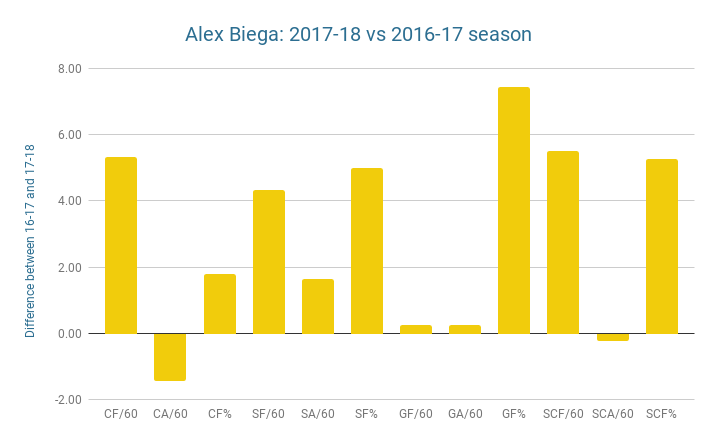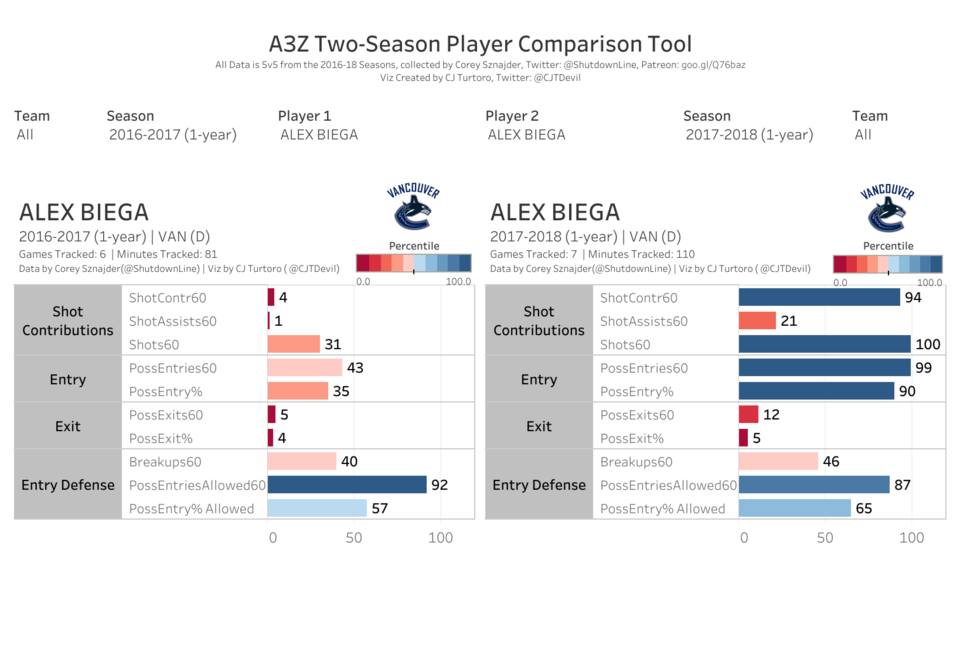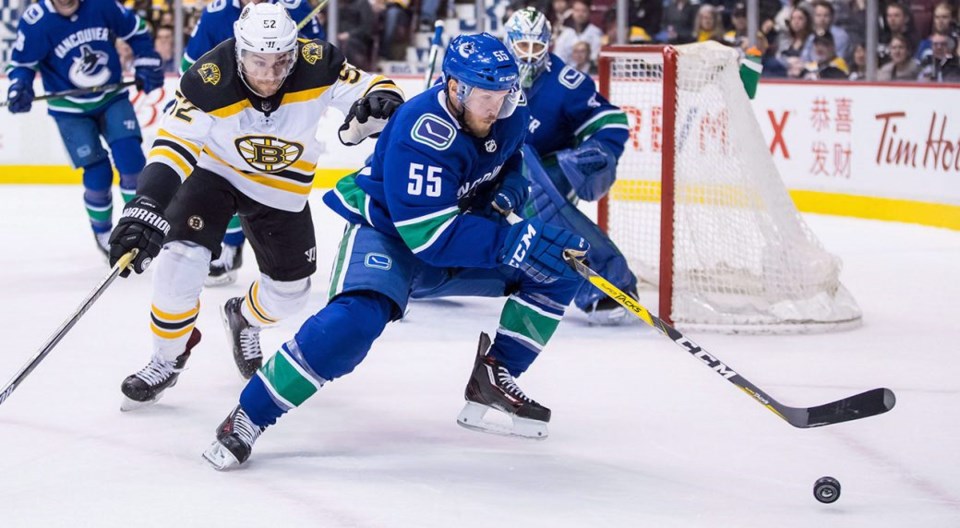“Alex Biega knows what he is,” said Canucks head coach Travis Green. Biega knows that he’s a depth defenceman, the type of guy called upon to sit in the press box for long stretches while other defencemen play big minutes in the NHL and AHL. He’s an example to the younger players off the ice, where his work ethic never changes even when he’s not playing. When he’s on the ice, Biega lives up to his nickname as the Bulldog, chasing down puck-carriers and finishing his checks.
Biega was one other thing during the 2017-18 season, which was far more unexpected: good.
Prior to last season, an argument could be made that Biega was one of the worst defencemen to play a regular shift in the NHL. That’s not an exaggeration: Dawson Sprigings’ Goals Above Replacement statistic had him as the fourth-worst defencemen in the NHL during the 2016-17 season. Since that statistic was cumulative, if he had played more than 36 games he would have easily been the worst.
Sprigings’ work has regrettably been wiped from the internet since he was hired by Kroenke Sports, the owners of the Colorado Avalanche and multiple other professional sports teams, so we don't have his data for this season. Judging from Biega's underlying numbers, however, he definitely wouldn't have been one of the worst defencemen this year.
In each of Biega's previous seasons, the Canucks were out-attempted, out-shot, out-chanced, and out-scored when Biega was on the ice at even-strength. In the 2017-18 season, however, the opposite was true. At 5-on-5, Biega led all Canucks defencemen in, well, pretty much everything.
That’s Biega leading the way in corsi, fenwick, shots-on-goal, goal, and scoring chance percentage. In other words, the Canucks out-attempted, out-shot, out-chanced, and out-scored their opponents with Biega on the ice, moreso than any other Canucks’ defenceman.
That’s weird.
Now, to be fair, it didn’t take much to lead all Canucks defencemen in any of those categories, because the Canucks weren’t particularly good last season. Biega may have led the Canucks’ defence in corsi, for instance, but he was 100th among all NHL defencemen that played at least 200 minutes at 5-on-5.
Even with that caveat, Biega’s improvement is still remarkable. He improved from last season in almost every area. The only exceptions? The Canucks allowed a slightly higher rate of shot attempts and scoring chances against with Biega on the ice than last season, but those were more than made up for by the offence the Canucks created with him on the ice.

So, what changed?
Perhaps with a new head coach, Biega was used differently. One explanation for improvement would be if he started more shifts in the offensive zone than last season, or saw weaker competition.
That doesn’t appear to be the case. Biega actually started a higher ratio of his shifts in the defensive zone last season than in 2016-17, so you would expect his puck possession numbers to be slightly worse. As for quality of competition, the difference between the competition he faced between the two seasons is negligible. In fact, by a couple ways of measuring quality of competition, he actually faced tougher competition in 2017-18.
Biega certainly faced weaker competition than defencemen like Alex Edler, Chris Tanev, and Troy Stecher, but it doesn’t appear to be the source of Biega’s improvement.
Another potential change in usage would be quality of teammates. Did Biega play with better quality players in 2017-18?
That was the hypothesis raised by Lauchlan in the comments of this week’s article on the defence pairing of Biega and Derrick Pouliot. Specifically, he suggested that head coach Travis Green’s heavy usage of Brandon Sutter in a checking role with the likes of Edler and Tanev freed up more skilled forwards to play with Biega and Pouliot.
At first glance, that hypothesis seems to bear itself out. The forwards that Biega played with most often were Henrik and Daniel Sedin, with whom he put up great underlying numbers.
There’s just one issue: the forwards Biega played with most often in 2016-17 were also Henrik and Daniel Sedin.
With zone starts even more heavily skewed towards the offensive zone, Biega put up significantly worse puck possession numbers when he was on the ice the Sedins in 2016-17 than he did last season. By most measures of quality of teammates, Biega saw little to no difference between the two seasons.
Perhaps it’s not the forwards that were the difference, but the quality of defencemen that Biega played with. Maybe Pouliot is just that good and lifted up Biega’s play?
There are a couple issues with that hypothesis. One is that Biega put up great underlying numbers with his most common defence partner in 2016-17, Nikita Tryamkin. The other is that Biega was just as good when he was paired with Ben Hutton this past season and his puck possession numbers really only suffered when he played with Michael Del Zotto.
Suffice it to say, Del Zotto had that effect on all his defence partners.
With little difference between the quality of competition he faced or the quality of teammates he played with, and little difference between his zone starts, what else could have changed?
There’s a big one that was alluded to earlier: a change of coaches. The switch from Willie Desjardins to Travis Green, along with the switch in defence coaches from Doug Lidster to Nolan Baumgartner, could have had a major impact. Perhaps the style and systems put in place by Green and Baumgartner were particularly well-suited to Biega.
“I think he understands my system,” said Green when the Canucks re-signed Biega earlier this year. “He’s physical and he gets shots to the net. He’s very dialed in when he plays. He’s a smart guy off the ice and he’s worked really hard on his game over the years. SInce the first time I met him, to see the player he’s become is something.”
Biega suggested that Green’s system allowed him to play to his strengths.
“I think can use my skating more, backwards skating, tracking guys,” said Biega. “That way, if you have tighter gaps, you don’t really have to block shots, you don’t have to give up those grade-A chances or whatnot. For me, if you’re closing guys off at the redline, and you can break the puck out, you’re not going to play in your zone much.”
What’s interesting is that Biega mostly refers to defensive changes — more aggressive with gap control and in the neutral zone — to spend less time in the defensive zone, but the biggest changes for Biega were offensive rather than defensive. The Canucks simply created more offensively with Biega on the ice, while giving up a similar number of shot attempts and chances.
But the Canucks were also more aggressive offensively with their system under Green, with defencemen more likely to jump up in the rush. We can see that by looking at the micro-stats tracked by Corey Sznajder, comparing Biega’s 2016-17 season with 2017-18.

The statistics in the bottom sector are from defending against zone entries and they look pretty much identical between 2016-17 and 2017-18. If more aggressive gap control and neutral zone defence made a huge difference, we’d likely see it here, but it doesn’t appear to have made any difference at all for Biega.
Similarly, there’s no difference in Biega’s zone exits. He wasn’t any more effective at getting the puck out of the defensive zone between the two seasons.
Where there’s a huge difference, however, is in zone entries and shot contributions. From the games Sznajder tracked, Biega was far, far more effective at successfully gaining the offensive zone with possession of the puck. Once in the offensive zone, Biega was more likely to contribute to shot attempts, whether taking the shot himself or setting up someone else.
That is reflected in his underlying numbers from the entire season, where no Canucks defenceman was on the ice for more shot attempts, scoring chances, or shots on goal at 5-on-5. He also took significantly more shots himself and his willingness to jump up in the rush aggressively showed in the number of scoring chances he took.
In 2016-17, Biega had 1.92 scoring chances per 60 minutes of ice time. Last season, that jumped up to 5.17, easily the best among Canucks defencemen. Next best was Troy Stecher, who had 3.15 scoring chances per 60 minutes.
If only Biega had some finishing ability, he probably would have had a lot more than just one goal.
Essentially, we’ve got two possibilities for Biega’s sudden improvement. Either he suddenly took a big step forward in his development at the age of 29, or he was uniquely suited to the new system introduced by Green and Baumgartner.
Neither explanation feels entirely satisfactory. Defencemen suddenly improving at 29 is extremely unlikely, and it seems odd that no other Canucks defencemen took a similar step forward, while several seemed to regress.
The bigger question, and one that’s even more difficult to answer, is whether Biega can sustain this improvement next season. If it’s not entirely clear how he improved so significantly last season, how do you identify what will work for the following season?
But, like Green says, Biega is a smart guy. Perhaps he’s figured out something that has eluded so many other defencemen. Even if he has, however, he still has modest goals.
“It’s coming to the rink every single night and it doesn’t change,” he said. “It’s proving that I can be a player and proving to myself that I can be a guy that can even surprise myself and be that guy that can maybe be a 5-6.”
Biega isn’t aiming to suddenly become a top-pairing defenceman or a power play quarterback. Instead, he simply wants to be an everyday NHLer on the third pairing.
After all, Biega knows what he is.
*Analytics via Natural Stat Trick and Corsica.



